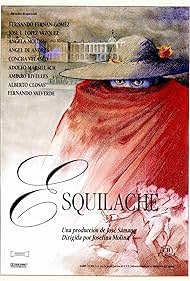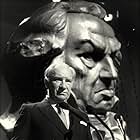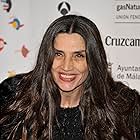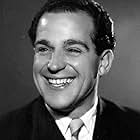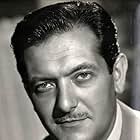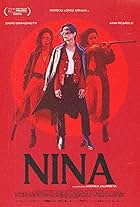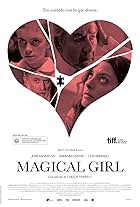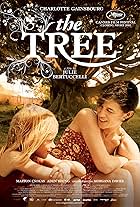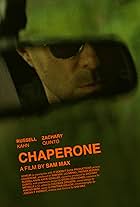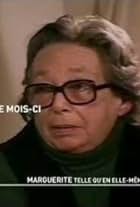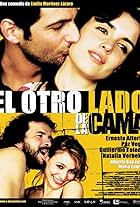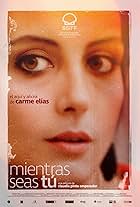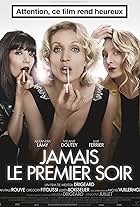In 18th-century Madrid, the Marquess of Esquilache, King Charles III of Spain's former minister, bans the wearing of the popular wide collar with a long coat and brimmed hat; this and other ... Read allIn 18th-century Madrid, the Marquess of Esquilache, King Charles III of Spain's former minister, bans the wearing of the popular wide collar with a long coat and brimmed hat; this and other measures provoke a massive riot in the city.In 18th-century Madrid, the Marquess of Esquilache, King Charles III of Spain's former minister, bans the wearing of the popular wide collar with a long coat and brimmed hat; this and other measures provoke a massive riot in the city.
- Awards
- 4 wins & 12 nominations
Photos
Ángela Molina
- Fernanda
- (as Angela Molina)
Tito Valverde
- Bernardo
- (as Fernando Valverde)
Francisco Portes
- Sabatini
- (as Paco Portes)
Josu Ormaetxe
- Cabecilla
- (as Jesús A. Ormaeche)
Storyline
Did you know
- TriviaDespite being set in the 18th century, Antonio Buero Vallejo's play on which the film is based sought to draw a parallel between enlightened despotism and Franco's regime.
- Quotes
Crowd: Long live the King, death to the bad government!
Featured review
The film is well based on historical events about Leopoldo Gregorio , Marquis of Esquilache (Messina, December 23, 1699 - Venice, September 15, 1785) , an Italian statesman who acted as minister of Charles III of Spain . Esquilache is a marvelous 1989 Spanish film , being excellently directed by Josefina Molina . The picture gives a magnificent portrayal to historic kingdom and cultural memory of an interesting period , with a look back to the past , offering us a provoking retelling on essential happenings . The film stars Fernando Fernán Gómez as Leopoldo De Gregorio , Marquis of Esquilache , who gives an awesome acting and it is based on the play "Un Soñador Para Un Pueblo" by Antonio Buero Vallejo.
This excellent picture recreates faithfully the historical facts , as several years separate us from the events are to narrate , but the shadows still hide from the public this great historic moment , and the significance of such deeds . ¨Esquilache¨ is filled with those lights and shadows , gathers such a very important known event recreated in the artistic frame called ¨Illustration¨ , characterized and inspired by the ideas of reason and freedom . The movie contributes to artistic and cultural record of an era , being masterfully narrated and perfectly played as well as directed . Here appear numerous historical characters competently performed , such as : Charles III by Adolfo Marsillach , Isabel De Farnesio interpreted by Amparo Rivelles , Duque De Villasanta by Alberto Closas and Marqués De Ensenada acted by Ángel De Andrés López . It displays a colorful and evocative cinematography by Juan Amoros , being shot on location in Royal Palace of Madrid . Luxurious sets make excellent use of real locations in Spain and it has a look of a great production . Attractive and magical musical score by José Nieto . The motion picture was stunningly directed by Josefina Molina who has received a honorific Goya , she has directed good flicks such as ¨Función De Noche¨, ¨Lo Mas Natural¨, ¨La Lola Se Va a Los Puertos¨ and the prestigious TV series ¨Tesesa De Jesus¨. The film was entered into the 39th Berlin International Film Festival and won numerous Goya Awards .
The film is very well set in Charles III epoch , he was the main promoting of Enlightened absolutism , also known as enlightened despotism and benevolent absolutism , it is a form of absolute monarchy or despotism inspired by the Enlightenment . As a lot of European Enlightened monarchs embrace rationality . Most enlightened monarchs fostered education and allowed religious tolerance , freedom of speech , and the right to hold private property . Charles III, King of Spain from 1759 to 1788, sought to rescue his empire from decay through ambitious reforms such as weakening the Church and its monasteries , promoting science and university research, facilitating trade and commerce, modernizing agriculture , and avoiding war . Charles III had been introduced to reform by his mentor in Sicily, Bernardo Tanucci. Although Tanucci remained behind in the Two Sicilies to advice Charles's son, King Ferdinand I of the Two Sicilies, as the two thrones could not be united by consequence of treaty, Charles carried with him a cadre of Italian reformers who saw potential in the Spanish bureaucracy for modernization. Spain relapsed into former patterns after his death . The most important political reforms this promoter monarch instituted in his kingdom included : Codifying the laws of their territories . Reforming the countryside by establishing who owned which land and by reporting this data in property surveys called Cadasters . Abolishing, or taking steps to abolish, aristocratic tax immunities . Limiting the nobility's power to police and pass judgement upon their peasants . Diminishing peasants' legal disabilities, including ameliorating , if not abolishing, the hereditary status and impositions of serfdom where they still existed . Establishing some measure of religious toleration . Sponsoring cultural activities and institutions . Other illustrated kings are the followings : Emperor Joseph II , ruler of Austria , Empress Catherine the Great and Senior ministers , such as the Marquis of Pombal, who was Joseph I of Portugal's prime minister, and Struensee in Denmark . And in Spain , Marques De Esquilache -originally Squillace- , who was born in Messina, de Gregorio was one of Enlightenment Spain's leading statesmen from the arrival of Charles III to the Marquis's death in 1785 . His ability as a military supplier for the Neapolitan army impressed the king and raised him to royal prominence. He was appointed "Marquis of Esquilache" in 1755 . His attempt to modernize the apparel of the average Spaniard resulted in the Esquilache Riots and in his dismissal . Charles was forced to make Esquilache ambassador to Venice. It was a move that both Charles and Esquilache lamented. Esquilache felt that his measures in Spain had deserved a statue, and would comment that he had cleaned and paved the city streets and had created boulevards, and had nevertheless been dismissed . He died in Venice.
This excellent picture recreates faithfully the historical facts , as several years separate us from the events are to narrate , but the shadows still hide from the public this great historic moment , and the significance of such deeds . ¨Esquilache¨ is filled with those lights and shadows , gathers such a very important known event recreated in the artistic frame called ¨Illustration¨ , characterized and inspired by the ideas of reason and freedom . The movie contributes to artistic and cultural record of an era , being masterfully narrated and perfectly played as well as directed . Here appear numerous historical characters competently performed , such as : Charles III by Adolfo Marsillach , Isabel De Farnesio interpreted by Amparo Rivelles , Duque De Villasanta by Alberto Closas and Marqués De Ensenada acted by Ángel De Andrés López . It displays a colorful and evocative cinematography by Juan Amoros , being shot on location in Royal Palace of Madrid . Luxurious sets make excellent use of real locations in Spain and it has a look of a great production . Attractive and magical musical score by José Nieto . The motion picture was stunningly directed by Josefina Molina who has received a honorific Goya , she has directed good flicks such as ¨Función De Noche¨, ¨Lo Mas Natural¨, ¨La Lola Se Va a Los Puertos¨ and the prestigious TV series ¨Tesesa De Jesus¨. The film was entered into the 39th Berlin International Film Festival and won numerous Goya Awards .
The film is very well set in Charles III epoch , he was the main promoting of Enlightened absolutism , also known as enlightened despotism and benevolent absolutism , it is a form of absolute monarchy or despotism inspired by the Enlightenment . As a lot of European Enlightened monarchs embrace rationality . Most enlightened monarchs fostered education and allowed religious tolerance , freedom of speech , and the right to hold private property . Charles III, King of Spain from 1759 to 1788, sought to rescue his empire from decay through ambitious reforms such as weakening the Church and its monasteries , promoting science and university research, facilitating trade and commerce, modernizing agriculture , and avoiding war . Charles III had been introduced to reform by his mentor in Sicily, Bernardo Tanucci. Although Tanucci remained behind in the Two Sicilies to advice Charles's son, King Ferdinand I of the Two Sicilies, as the two thrones could not be united by consequence of treaty, Charles carried with him a cadre of Italian reformers who saw potential in the Spanish bureaucracy for modernization. Spain relapsed into former patterns after his death . The most important political reforms this promoter monarch instituted in his kingdom included : Codifying the laws of their territories . Reforming the countryside by establishing who owned which land and by reporting this data in property surveys called Cadasters . Abolishing, or taking steps to abolish, aristocratic tax immunities . Limiting the nobility's power to police and pass judgement upon their peasants . Diminishing peasants' legal disabilities, including ameliorating , if not abolishing, the hereditary status and impositions of serfdom where they still existed . Establishing some measure of religious toleration . Sponsoring cultural activities and institutions . Other illustrated kings are the followings : Emperor Joseph II , ruler of Austria , Empress Catherine the Great and Senior ministers , such as the Marquis of Pombal, who was Joseph I of Portugal's prime minister, and Struensee in Denmark . And in Spain , Marques De Esquilache -originally Squillace- , who was born in Messina, de Gregorio was one of Enlightenment Spain's leading statesmen from the arrival of Charles III to the Marquis's death in 1785 . His ability as a military supplier for the Neapolitan army impressed the king and raised him to royal prominence. He was appointed "Marquis of Esquilache" in 1755 . His attempt to modernize the apparel of the average Spaniard resulted in the Esquilache Riots and in his dismissal . Charles was forced to make Esquilache ambassador to Venice. It was a move that both Charles and Esquilache lamented. Esquilache felt that his measures in Spain had deserved a statue, and would comment that he had cleaned and paved the city streets and had created boulevards, and had nevertheless been dismissed . He died in Venice.
Details
- Release date
- Country of origin
- Languages
- Also known as
- Markiz Esquilache
- Filming locations
- Production company
- See more company credits at IMDbPro
- Runtime1 hour 40 minutes
- Sound mix
Contribute to this page
Suggest an edit or add missing content

